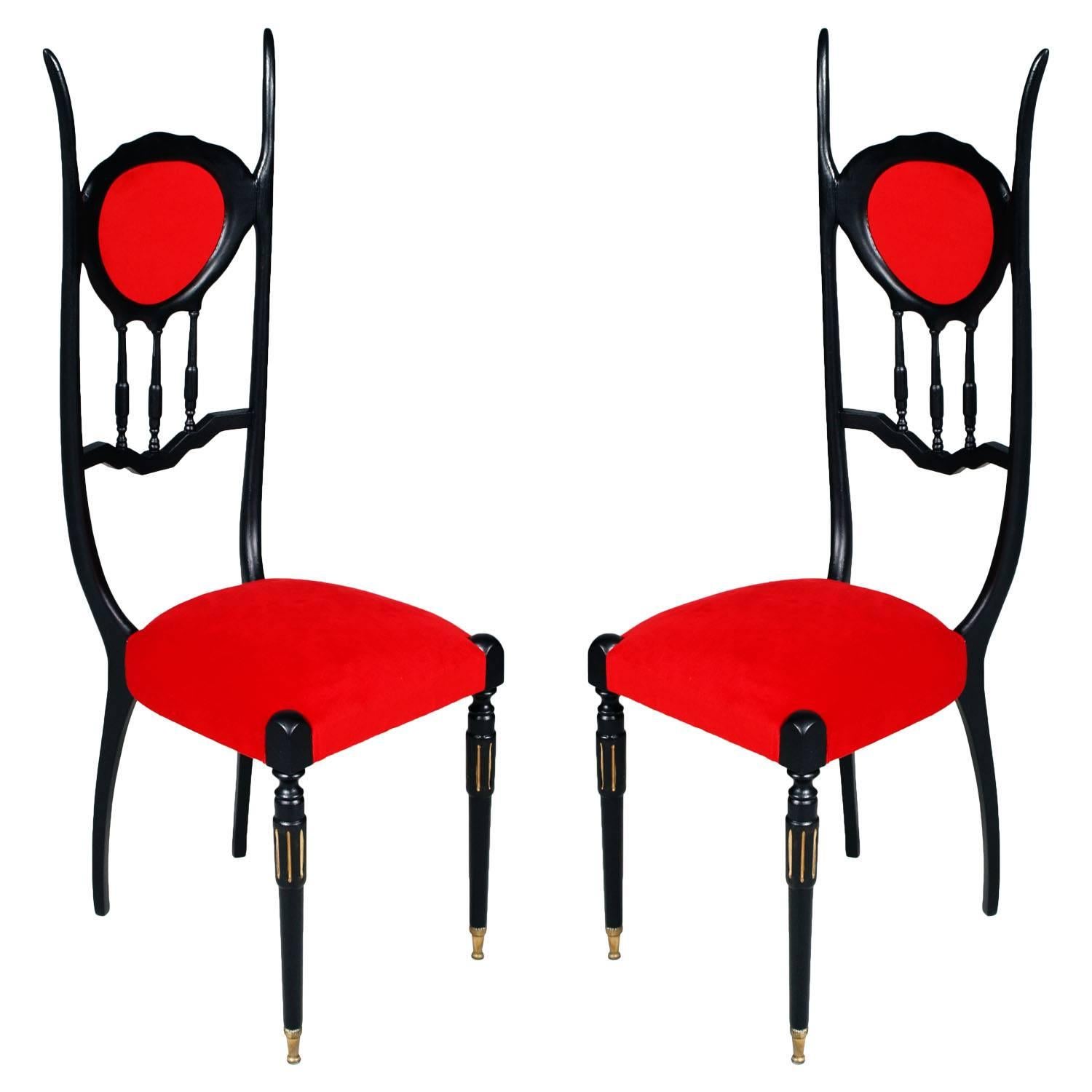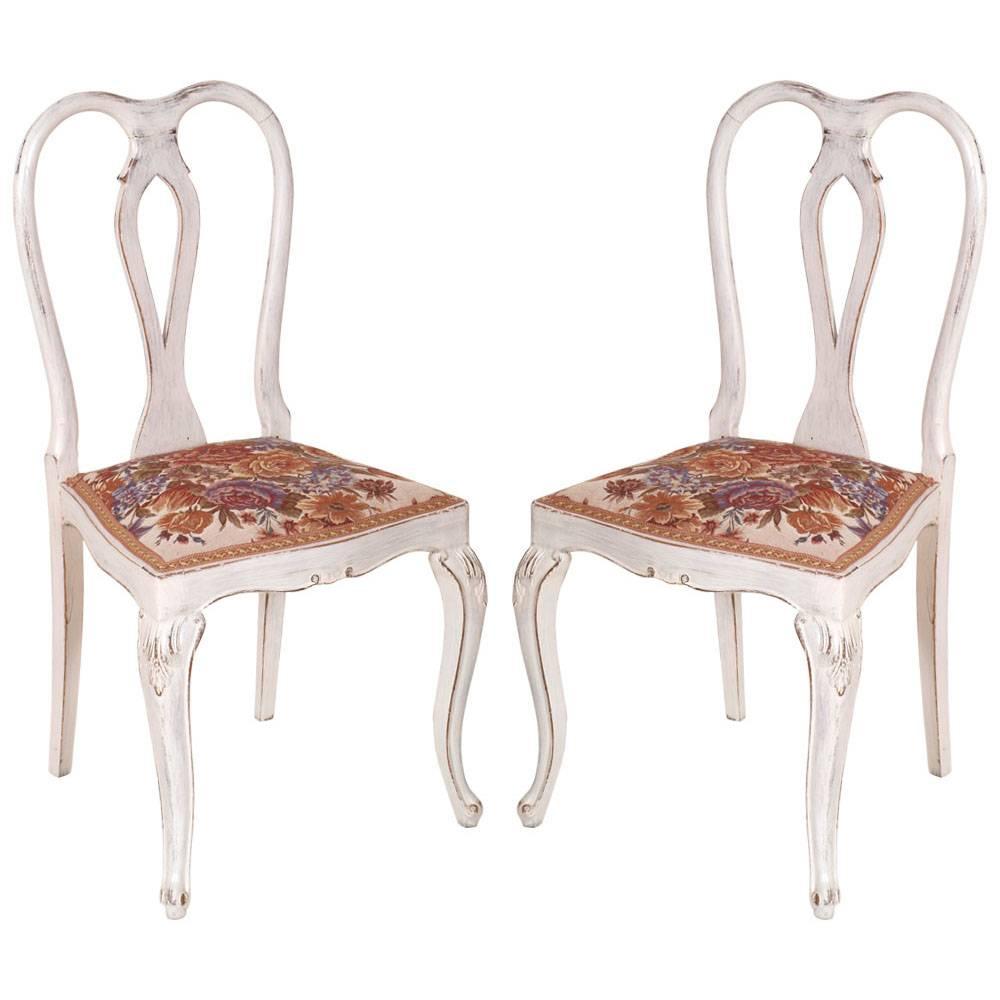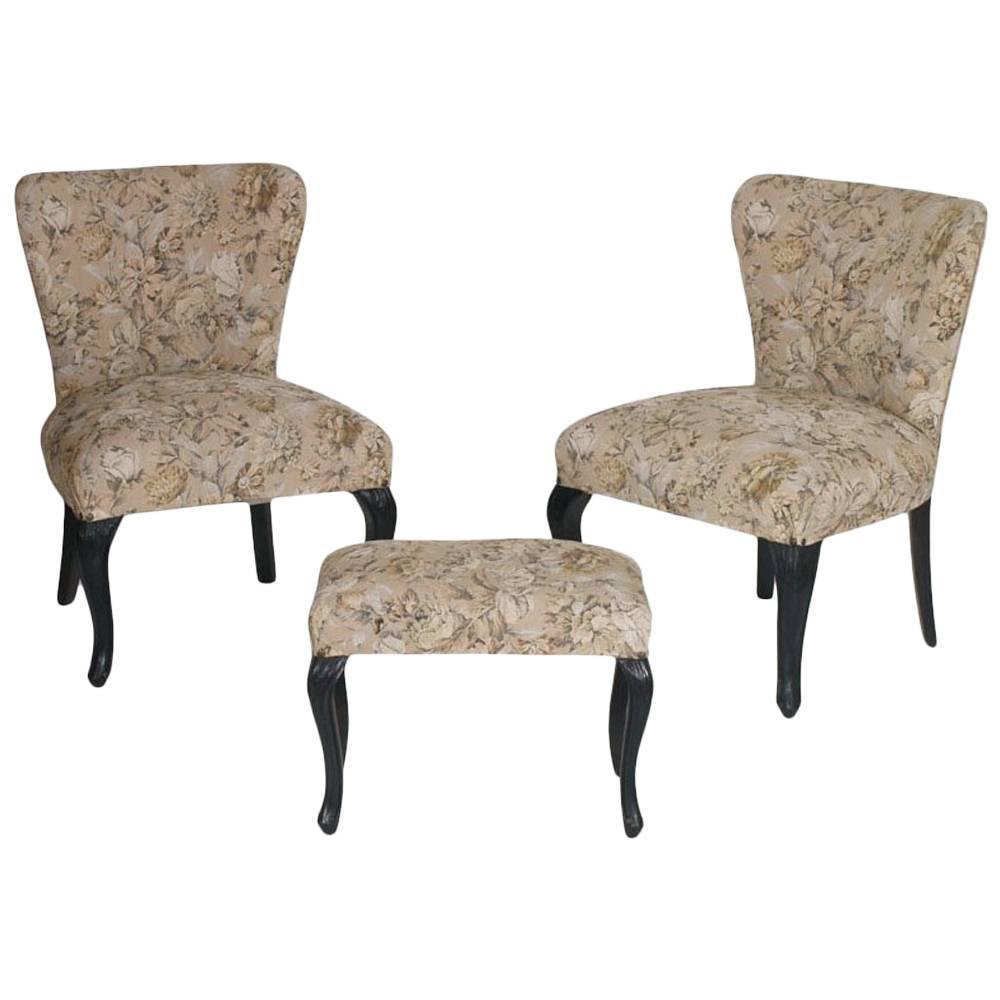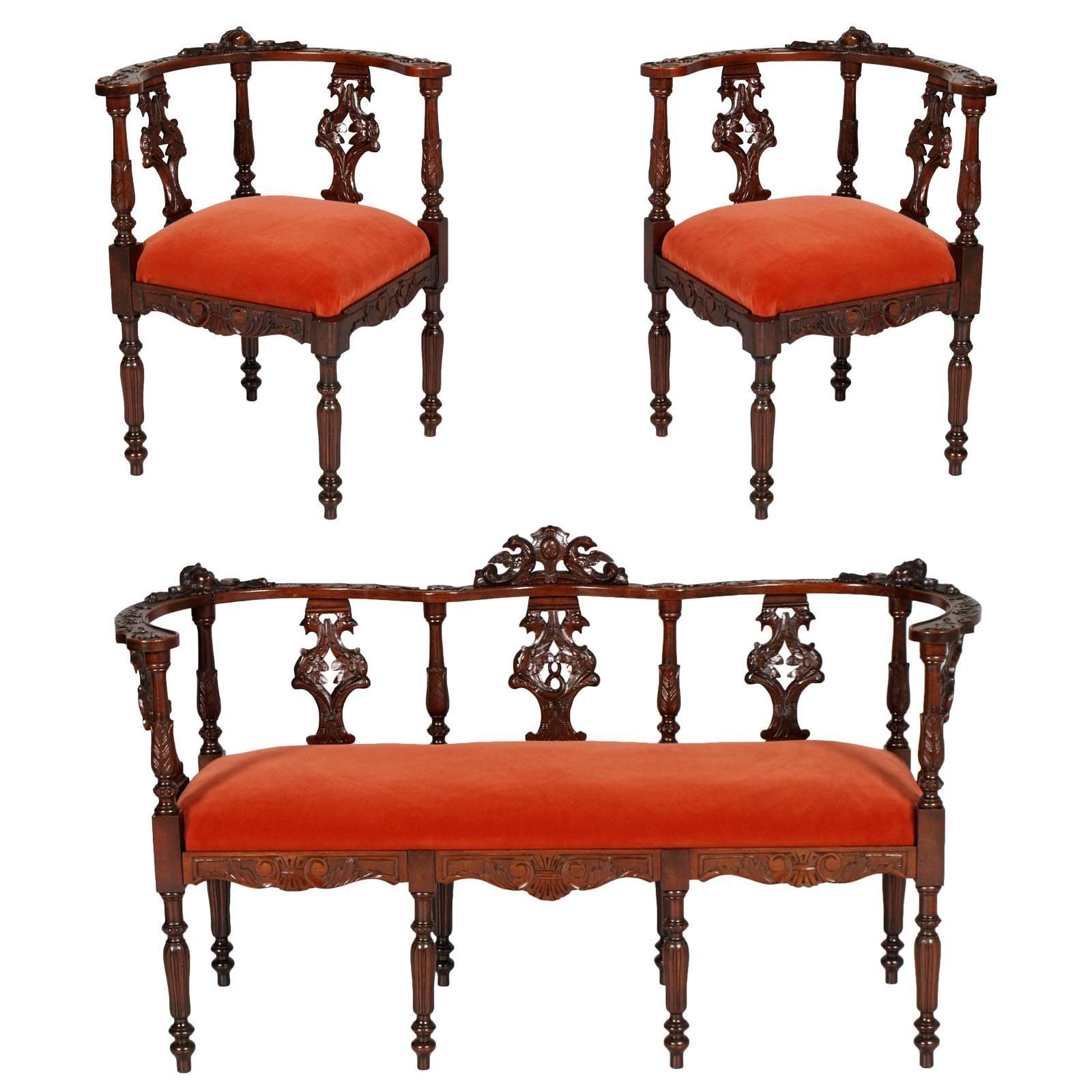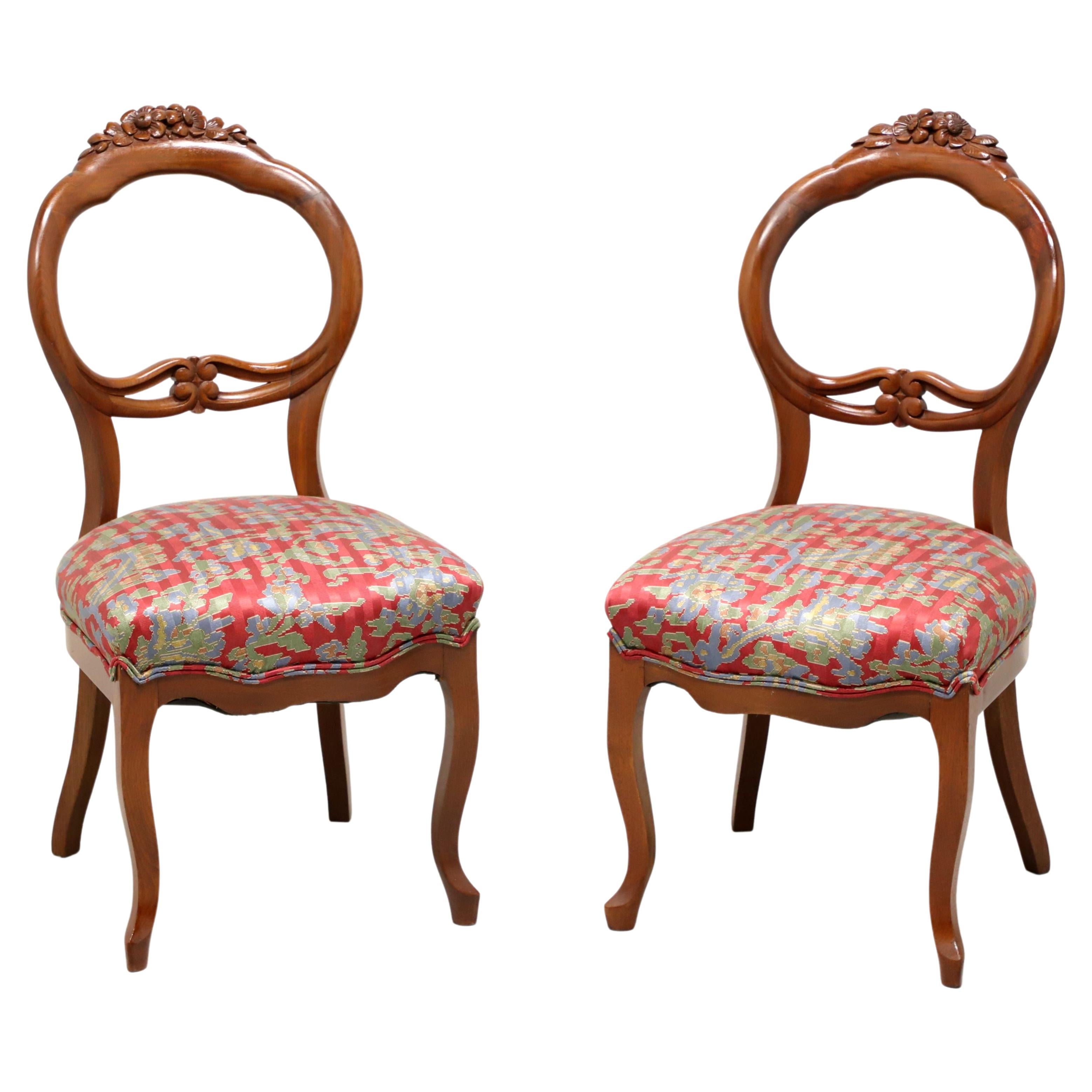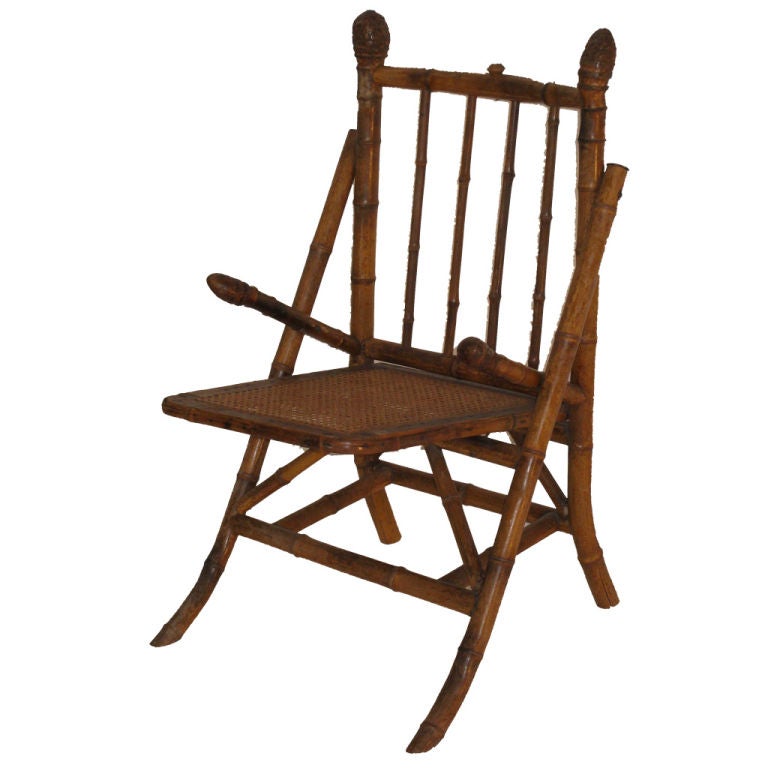Items Similar to Early 20th Century Pair Eclectic Venice Chairs in Walnut by Testolini Frères
Want more images or videos?
Request additional images or videos from the seller
1 of 10
Early 20th Century Pair Eclectic Venice Chairs in Walnut by Testolini Frères
About the Item
Spectacular pair of chairs extensively carved in the eclectic style of the Art Nouveau period by the Testolini Brothers of Venice. In hand-carved and ebonized walnut.
Due to their elegance and refinement they embellish any type of context
ABOUT TESTOLINI
The Testolinis were definitely at the forefront of their times and, not being able to immediately create the glass creations they designed, they subcontracted the production to the Salviati company, with which, however, they signed an economic-commercial agreement, which meant that their products, especially the furniture, were also resold in their international stores. The Testolinis, in fact, supplied all the major international retailers, and in their shops there was a volume with the shipping costs of each individual object, which any private buyer could have browsed if they intended to have the purchased pieces shipped. In addition to the shipping costs, there were also the sales prices of each creation, divided according to quality: I, II or III. In fact, another extraordinary thing for the time was that the Testolini Brothers created three production lines for each model in the catalogue, to ensure that every social group could access their products.
With an uncommon intelligence, the Testolinis distributed free advertising material and small sales catalogues, as well as postcards, which portrayed their major sales locations with exquisite taste; they even went as far as distributing free tourist guides at the city train station, where naturally many pages were dedicated to their locations and achievements. What was destined to become a lesson was the possibility for each Testolini customer to receive a ticket with which they could visit their Murano furnaces for free.
Production never stopped: between the goods sold in their shops, those sent to third parties and those given to Salviati and CVM, the Testolinis found themselves forced to subcontract work to all the Venetian artisans, especially the most skilled ones, who often rewarded granting them the possibility of reproducing some models from their catalogue. Their intense production led them to adopt all the most modern machinery, which led to the modernization of the entire city, so much so that for this reason, prior to 1896, they were awarded first the knighthood and then the title of Officers of the Order of the Crown , for the progress and development brought to Venetian industry. Honors that the Testolinis were proud to show off together with the prizes won at all the national and international exhibitions in which they had participated.
In the long life of the company - it lasted almost a century - several variations of the same name were used, Fratelli Testolini, M.Q. Testolini, Testolini, together with their foreign language variants Testolini Brothers or Frères, which often generates some misunderstanding.
Very interesting and truly pioneering in behavior is the fact that, given the international public that visited their stores, the employees were selected based on their knowledge of different languages, in order to make foreign customers feel more at ease.
Unlike today, the most appreciated and requested product in Venice in the 19th century was carved furniture, a sector in which the Testolinis truly excelled, and in any case they dedicated themselves with equal imagination and professionalism to glass creations, designing models that are still in production today and even inventing a new typology of objects with a simple and elegant shape, cobalt blue in colour, but with an exuberant enamel decoration imitating lace.
Carved furniture was their cornerstone; they even invented the only original style of the 19th century, the cave style. They then designed highly original Umbertine style furniture, whose success lasted uninterrupted until the company closed. They indulged in neo-rococo and defined what is recognized in furniture as the Italian neo-Renaissance.
They enjoyed creating mirrors of all types, with open mirrors embraced by dragons or devils, or surrounded by series of cherubs; some had colored glass frames, others micromosaics, still others combined carvings, glass and mosaics.
Every piece that came out of the Testolini laboratories was a masterpiece of imagination, ingenuity and mastery, but unfortunately, despite the inexhaustible artistic vein, the Testolinis also found themselves having to deal with the unexpected: at the end of the 19th century, a very strong economic stagnation led many companies to close or downsize; to escape bad luck, as well as due to the disinterest shown by one of the two cousins to whom the company had been inherited, a merger was opted for with other important companies, including Salviati and Jesurum, which were merged under the aegis of Salviati Jesurum & Co. The merger was implemented only in 1902, and indeed it did not last until 1906, but led Testolini to give up a good part of its production, selling many of the highly appreciated and famous models to the other companies that became part of of the new large family and alienating many of the important exhibition and production sites.
Marco Testolini, unlike his cousin, did not abandon the company, on the contrary, he kept the carpentry workshop in Palazzo Labia active; he also tried to restore prestige to the family name by renaming the company, after the dissolution in 1906, with his name, Marco Testolini. The laboratory in Palazzo Labia continued its production, supplying as always the other companies, including Pauly & Cie, which had recently purchased their headquarters in Palazzo Barbarigo.
At the end of the 1930s, the change in fashions and tastes made the extraordinary Testolini production a mere specter of what it had been, a circumstance which, combined with the request to vacate the premises for the sale of Palazzo Labia, led to the end of Testolini activities. Marco, although in those years he had tried in every way to keep the family business alive, threw in the towel and surrendered to the inevitable. Gradually the name Testolini faded and disappeared; oblivion swallowed up the largest Venetian company, which had influenced the taste of the lagoon capital of the 19th century, a company appreciated worldwide, whose creations are present in many museums and private collections, but whose importance no one remembers anymore .
Published in Art and Design by Andrea Massimo Basana.
Andrea Massimo Basana, art historian, has forensically deepened his knowledge in the antiquarian field; lover and admirer of applied arts, he was for several years a cultural operator for the Municipality of Belluno and creator of content for the "Lace and Lace" page. Collector and scholar, he has published various articles and held various conferences, he continues his research on the Testolini Brothers' company.
- Creator:Testolini & Salviati (Designer)
- Dimensions:Height: 50.4 in (128 cm)Width: 19.69 in (50 cm)Depth: 19.69 in (50 cm)Seat Height: 19.3 in (49 cm)
- Sold As:Set of 2
- Style:Art Nouveau (Of the Period)
- Materials and Techniques:
- Place of Origin:
- Period:1900-1909
- Date of Manufacture:1900-1910
- Condition:Wear consistent with age and use.
- Seller Location:Vigonza, IT
- Reference Number:
About the Seller
4.9
Vetted Seller
These experienced sellers undergo a comprehensive evaluation by our team of in-house experts.
Established in 2017
1stDibs seller since 2017
283 sales on 1stDibs
Typical response time: 3 hours
- ShippingRetrieving quote...Ships From: Vigonza, Italy
- Return PolicyThis item cannot be returned.
More From This SellerView All
- Early 20th Century Baroque Service Table by Testolini Freres Venice wax PolishedBy Testolini & SalviatiLocated in Vigonza, PaduaElegant, precious and refined Venetian service table, Baroque, in wax-polished solid walnut with exceptional patina. Built in the early 1900s by the f...Category
Early 20th Century Italian Baroque Revival Side Tables
MaterialsWalnut
- Venetian Early 20th Century Eclectic Credenza with Mirror, by Testolini SalviatiBy Testolini & SalviatiLocated in Vigonza, Padua1920s precious and refined Venetian eclectic mirrored credenza sideboard by Testolini & Salviati. Sideboard splendid in all its parts with three centr...Category
Early 20th Century Italian Art Nouveau Credenzas
MaterialsMahogany, Walnut
- Early 20th Century Pair of Art Decò Nightstands Tables by Testolini VeniceBy Testolini & SalviatiLocated in Vigonza, PaduaPair of art decò nightstands , early 1900s by Testolini Frères Venice, two-tone walnut veneer and with beech inlay. Golden metal handles embellished with a bakelite insert, a preciou...Category
Early 20th Century European Art Deco Night Stands
MaterialsWalnut
- Venetian Early 20th C. Eclectic Credenza China Cabinet by Testolini & SalviatiBy Testolini & SalviatiLocated in Vigonza, Padua1920s precious and refined Venetian eclectic credenza sideboard with china cabinet by Testolini & Salviati. Splendid sideboard in all its parts. Beve...Category
Early 20th Century Italian Belle Époque Credenzas
MaterialsCrystal
- Early 20th Century Mirror Art Nouveau by Testolini & Salviati, Carved WalnutBy Testolini & SalviatiLocated in Vigonza, Padua1900s mirror Art Nouveau by Testolini & Salviati, solid hand-carved walnut restored and polished to wax. Bevelled heart mirror, hand-carved walnut ...Category
Early 20th Century Italian Art Nouveau Wall Mirrors
MaterialsMirror, Walnut
- Venice Baroque Naightstands Bella Epoque, Walnut and Briar, by Testolini FreresBy Testolini & SalviatiLocated in Vigonza, PaduaVenice Baroque bedside tables by Testolini Freres, Bella Epoque period, walnut and briar with burnished bronze handles, mahogany interior. Wax polishedCategory
Early 20th Century Art Nouveau Night Stands
MaterialsWalnut
You May Also Like
- Antique Early 20th Century Walnut Victorian Balloon Back Side Chairs - PairLocated in Charlotte, NCA pair of antique Victorian balloon back side chairs, unbranded. Walnut with decorative floral carving to crest rail, carved backrest, multi-color floral fabric upholstered seat and ...Category
Early 20th Century American Victorian Side Chairs
MaterialsFabric, Walnut
- Early 20th Century English Bamboo ChairLocated in Chicago, ILEarly 20th century English bamboo chair Great accent piece in any decor More of an accent chair than conversational seating.Category
Early 20th Century Unknown Side Chairs
MaterialsBamboo, Cane
- Sculptural Early 20th Century Ethiopian ChairLocated in Chicago, ILA wonderfully sculptural early 20th century Ethiopian side chair with a hide seat and back stitched with hide strips, and stretched over a primitive wood frame. Chair is functional, ...Category
Early 20th Century Ethiopian Tribal Side Chairs
MaterialsHide, Wood
- Pair of Early 20th Century English Egyptian Revival ChairsLocated in Chicago, ILAn incredibly rare pair of early 20th century English Egyptian Revival slipper chairs inspired by an Egyptian 18th Dynasty chair discovered in 1905. The frames are carved of walnut and feature legs carved to imitate the fore and hind legs of lions, with caned seats, and new down filled silk velvet tiger cushions.Category
Antique Early 1900s English Egyptian Revival Slipper Chairs
MaterialsWalnut, Silk, Cane
- Antique Pair Sheraton Revival Side Chairs Early 20th CenturyLocated in London, GBA superb and striking pair of Sheraton Revival mahogany and satinwood banded chairs, Circa 1900 in date. The high back chairs feature satinwood banding with boxwood and ebonised line inlay and wonderful foliate carved decoration. The square tops are supported by a pair of ionic columns which frame rails above criss-cross splats. The overstuffed golden upholstered seats are above satinwood banded seat rails and the chairs are raised on reeded taping legs that terminate in decoratively carved spade feet. It is rare to find such a perfectly sculpted pair of chairs. THE BOTANICAL NAME FOR THE MAHOGANY THESE CHAIRS ARE MADE OF IS SWIETENIA MACROPHYLLA AND THIS TYPE OF MAHOGANY IS NOT SUBJECT TO CITES REGULATION. Condition: In excellent condition having been cleaned, polished, and waxed in our workshops. Please see photos for confirmation. Dimensions in cm: Height 96 x Width 47 x Depth 49 - Chairs Dimensions in inches: Height 3 foot, 2 inches x Width 1 foot, 6 inches x Depth 1 foot, 7 inches - Chairs Thomas Sheraton (1751 - 1806) was an English cabinetmaker and one of the leading exponents of Neoclassicism. Sheraton gave his name to a style of furniture characterised by a feminine refinement of late Georgian styles and became the most powerful source of inspiration behind the furniture of the late 18th century. His four-part Cabinet-Maker and Upholsterers’ Drawing Book greatly influenced English and American design. Sheraton was apprenticed to a cabinetmaker, but he became better known as an inventor, artist, mystic, and religious controversialist. Initially he wrote on theological subjects, describing himself as a “mechanic, one who never had the advantage of collegiate or academical education.” He settled in London c. 1790, and his trade card gave his address as Wardour Street, Soho. Supporting himself mainly as an author, Sheraton wrote Drawing Book (1791), the first part of which is devoted to somewhat naive, verbose dissertations on perspective, architecture, and geometry and the second part, on which his reputation is certainly based, is filled with plates that are admirable in draftsmanship, form, and proportion. In 1803 Sheraton, who had been ordained a Baptist minister in 1800, published his Cabinet Dictionary (with plates), containing An Explanation of All Terms Used in the Cabinet, Chair and Upholstery Branches with Dictionary for Varnishing, Polishing and Gilding. Some of the designs in this work, venturing well into the Regency style, are markedly unconventional. That he was a fashionable cabinetmaker is remarkable, for he was poor, his home of necessity half shop. It cannot be presumed that he was the maker of those examples even closely resembling his plates. Although Sheraton undoubtedly borrowed from other cabinetmakers, most of the plates in his early publications are supposedly his own designs. The term Sheraton has been recklessly bestowed upon vast quantities of late 18th-century painted and inlaid satinwood furniture...Category
Antique Early 1900s Sheraton Side Chairs
MaterialsMahogany, Satinwood
- Three Early 20th Century French Walnut Carved Side Chairs, circa 1900Located in San Francisco, CAThree early 20th century French walnut carved side chairs, circa 1900 Classic French walnut side chairs. Each chair is carved from solid waln...Category
Early 20th Century French French Provincial Side Chairs
MaterialsWalnut
